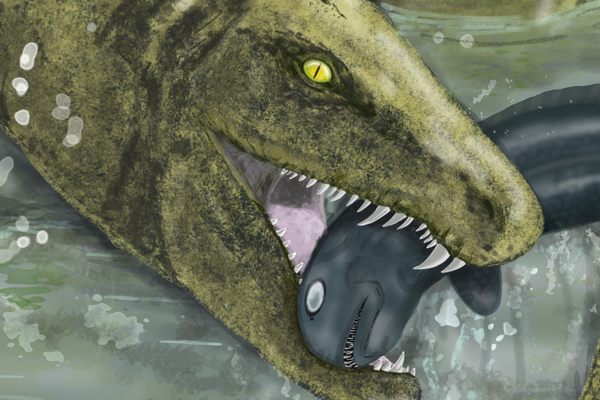Meet the Algae and Other Microbes in Your Neighborhood
All you need is a jar of local water and a microscope—you may even find new species. Welcome to Algae Obscura.
It was the last night of a rainy, miserable week—a family vacation to North Carolina gone wrong—when I pulled off the road and parked beside a nondescript marsh. As another round of storm clouds approached, I walked onto a small wooden dock and filled a jar with water, shoving a few pieces of marsh grass inside. My expectations were low as I drove back to the rental house and started looking at the sample through my microscope. Then I screamed.
The pieces of grass were coated with slimy brown film, and within it I saw a tiny, teardrop-shaped scaly cell wall with curved blue-green structures inside. These were the telltale signs of something even I, a microbiologist, had never expected to find in a random North Carolina swamp. Was this single-celled organism on the grass sample really Paulinella? This genus of amoeba includes a handful of rare and elusive species that are coveted by biologists around the world—unlike most amoebas, which cannot produce their own food, a few Paulinella species are capable of doing so using photosynthesis, an evolutionary quirk that we still can’t fully explain. But none of these species had been documented in North America for nearly a century. It was possible I was looking at a species new to science.
Within minutes, after an exchange of texts and images with my boss and coworkers, I had confirmation: It appeared to be a new photosynthesizing species of Paulinella. While this find was meaningful to me personally and professionally, it’s not unusual. In fact, most microbes on our planet remain undiscovered. You don’t have to go to the ends of the earth, or even North Carolina, to find new species—they might be right in your backyard, and it takes very little time, money, or specialized knowledge to find them.

For centuries, naturalists identified new species by first collecting water samples from anywhere and everywhere. Then they observed what they saw, often with the most basic of microscopes, sketched the organisms, and took detailed notes. These methods live on within today’s hobby microscopy community, where most people have no formal scientific training. To try it out, you’ll need a modest amount of equipment to collect samples, observe and document the microorganisms living in them, and identify what you’re seeing. Let’s get started.
What You’ll Need
To collect samples, all you really need is a glass jar with a twist-on lid—a jam or pizza sauce jar is the perfect size—and a body of water, anything from a puddle to an ocean. When sampling, look for something slimy, like a dead plant, wet soil, or anything green and floating in the water. Add a handful of this stuff to your jar and then make sure there is enough water that it’s fully submerged. Next, place the jar in a sunlit window for a few hours or days. You should start to see some small animals, such as insect larvae, snails, and tiny crustaceans called copepods moving around.
Now you’re ready to make some observations! Get or borrow a basic microscope—brands offering relatively inexpensive models, sometimes under $100, include Amscope, Motic, and Omax. Look for a compound light microscope that has a range of magnifications, such as 4x-1000x, so you can view different sizes of microbes. At a minimum, you should also buy glass slides and either disposable plastic pipettes or an eye dropper. Once you have your sample and your equipment, just place a drop of water from the jar onto a microscope slide and add a glass coverslip on top to flatten it out. Try taking water from the bottom of the jar, where the denser goo is, but make sure it is dilute enough that light from the microscope can still shine through—your drop should be equal parts gunk and water.

To document what you see in your microscope, you have a few options. Many people use an inexpensive adapter (starting around $25) to connect their smartphone to the scope’s ocular lens. There are also specialized cameras that you can slide onto your microscope and hook up to a computer monitor, but they can get expensive. You can also go old school and simply observe and sketch what you see, no camera necessary.
There’s one more thing you’ll need: resources to help you figure out what you’ve found. Microbes can be notoriously hard to identify, even with practice. Field guides such as Freshwater Algae of North America (or your geographical equivalent) can be expensive; look for a used copy, or post your photos on iNaturalist, which crowdsources potential IDs. There are also several great online communities of people who love helping with identifications, such as the Facebook Group Amateur Microscopy and Instagram. The latter is primarily where I share my findings and learn from the wonderful photos and videos of others.
What You May Find
A majority of the strange cells you’ll encounter are protists which are (mostly) single-celled organisms, typically larger than bacteria and visible with any microscope. Protist cells look a lot like our own: We both store our DNA in a nucleus and have organelles like mitochondria that keep us energized. The only difference is that protists figured this out more than a billion years before we existed. In fact, all plants, animals, and fungi alive today evolved from protist ancestors.
Protists you might observe spinning, eating each other, pooping, or reproducing on your glass slide include a variety of amoebas, ciliates, and algae, such as diatoms, plus many more. While they exist in their own microscopic ecosystems, they form the base of food webs that support all other life on the planet.

For example, diatoms convert light energy into sugars, releasing oxygen during this process of photosynthesis. Larger organisms feed on these sugary algae and even larger organisms, like fish, consume them. When not being eaten, diatoms are so good at their job that they alone have produced about 25 percent of all the oxygen in our atmosphere—that’s one out of every four breaths we take. Diatoms are easy to spot in water samples because of their vibrant golden color, which comes from light-harvesting pigments. They also have beautiful, intricate shapes—circles (my favorite), diamonds, cylinders, even triangles and stars—that have been admired since Victorian times. You will almost certainly find diatoms in any pond, puddle, bird bath, or ocean sample you collect.
Unlike diatoms, you won’t find glaucophytes in every sample, but perhaps that’s why you should look for them. These blue-tinted organisms, another kind of algae, resemble round gems surrounded by clear goop. Glaucophytes were perhaps the first organisms to gain photosynthesis from cyanobacteria, around two billion years ago. It’s hard to study them because they are extremely rare, but I’ve found them three times, including once from a smelly pond right by my office, and again in a small stream flowing into a sewer. They are as thrilling to find as a Mickey Mantle baseball card in an old attic box. And, like the photosynthesizing Paulinella species, they contain clues to a deep evolutionary past—and the interconnected present of all life on Earth.
The organisms swimming on your slides play a role in everything from the air we breathe to the food we eat, and learning more about them can be deeply rewarding. Science also benefits if more of us take the time and effort to observe these smallest citizens of Earth—think of them as the Algae Obscura—and to share what we see, perhaps for the first time ever.






















Follow us on Twitter to get the latest on the world's hidden wonders.
Like us on Facebook to get the latest on the world's hidden wonders.
Follow us on Twitter Like us on Facebook